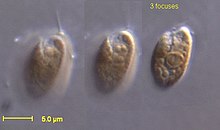Cryptista: differenze tra le versioni
Vai alla navigazione
Vai alla ricerca
Contenuto cancellato Contenuto aggiunto
←Nuova pagina: {{Tassobox |nome = Cryptista |immagine = Rhodomonas_salina_CCMP_322.jpg |didascalia = <!-- CLASSIFICAZIONE CLASSICA --> |dominio = Eukaryota |regno = Chromista |sottoregno = Hacrobia |phylum = CriptystaAdl et al., 2018 [Cavalier-Smith 1989, 2018]<ref>{{Cite journal|last1=Adl|first1=Sina M.|last2=Bass|first2=David|last3=Lane|first3=Christopher E.|last4=Lukeš|first4=Julius|last5=Schoch|first5=Conrad L.|last6=Smirnov|first6=Alexey|last7=Agatha|firs... |
(Nessuna differenza)
|
Versione delle 21:07, 21 mag 2023
| Cryptista | |
|---|---|
 | |
| Classificazione filogenetica | |
| Dominio | Eukaryota |
| (clade) | (sottodominio) Bikonta |
| (clade) | (supergruppo) Eubikonta |
| (clade) | (gruppo) Diaphoretickes |
| (clade) | (sottogruppo) EuDiaphoretickes |
| (clade) | (superregno) Cryptista |
| Classificazione classica | |
| Dominio | Eukaryota |
| Regno | Chromista |
| Sottoregno | Hacrobia |
| Phylum | CriptystaAdl et al., 2018 [Cavalier-Smith 1989, 2018][1] |
| subphylum (classica) | |
| Regni (filogenetica) | |
Cryptista è un clade di eucarioti simili ad alghe. È molto probabilmente correlato a Archaeplastida che comprende piante e molte alghe, all'interno del gruppo più ampio Diaphoretickes.[2]
Sebbene a volte sia stato collocato insieme ad Haptista nel gruppo Hacrobia, all'interno del regno Chromista,[3] studi più recenti hanno scoperto che Hacrobia non è un clade.[4] Ad esempio, nel 2016, un ampio studio filogenomico ha rilevato che i criptisti rientrano nel gruppo Archaeplastida, mentre gli aptofiti sono strettamente correlati al supergruppo SAR.[5][6]
Tassonomia
Basato su studi condotti da Cavalier-Smith, Chao & Lewis 2015[7][8]
- Clade Corbielia
- Sottoclade Microheliellida Tedersoo 2017
- Phylum Microheliellida Tedersoo 2017 [Endohelia Cavalier-Smith 2015]
- Classe Endohelea Cavalier-Smith 2012
- Phylum Microheliellida Tedersoo 2017 [Endohelia Cavalier-Smith 2015]
- Sottoclade Microheliellida Tedersoo 2017
- Clade Cryptista s.s.
- Sottoclade Palpitia Cavalier-Smith 2013 stat. nov.
- Phylum Palpitophyta Tedersoo 2017
- Classe Palpitea Cavalier-Smith 2012
- Phylum Palpitophyta Tedersoo 2017
- Sottoclade Rollomonadia Cavalier-Smith 2013 stat. nov.
- Phylum Kathablepharidophyta Okamoto & Inouye 2005 [Leucocrypta Cavalier-Smith 2015]
- Classe Leucocryptea Cavalier-Smith 2004[9] [Kathablepharidea (sic) Okamoto & Inouye 2005; Kathablefaridophyceae]
- Phylum Cryptophyta Pascher 1913 em. Adel et al. 2012 (Cryptomonada Cavalier-Smith 2004 sta. n.]
- Classe Goniomonadea Cavalier-Smith 1993
- Classe Cryptophyceae Fritsch 1937
- Phylum Kathablepharidophyta Okamoto & Inouye 2005 [Leucocrypta Cavalier-Smith 2015]
- Sottoclade Palpitia Cavalier-Smith 2013 stat. nov.
Note
- ^ Revisions to the Classification, Nomenclature, and Diversity of Eukaryotes, in The Journal of Eukaryotic Microbiology, vol. 66, n. 1, 26 settembre 2018, pp. 4–119, DOI:10.1111/jeu.12691.
- ^ Adl SM, Bass D, Lane CE, Lukeš J, Schoch CL, Smirnov A, Agatha S, Berney C, Brown MW, Burki F, Cárdenas P, Čepička I, Chistyakova L, Del Campo J, Dunthorn M, Edvardsen B, Eglit Y, Guillou L, Hampl V, Heiss AA, Hoppenrath M, James TY, Karnkowska A, Karpov S, Kim E, Kolisko M, Kudryavtsev A, Lahr DJ, Lara E, Le Gall L, Lynn DH, Mann DG, Massana R, Mitchell EA, Morrow C, Park JS, Pawlowski JW, Powell MJ, Richter DJ, Rueckert S, Shadwick L, Shimano S, Spiegel FW, Torruella G, Youssef N, Zlatogursky V, Zhang Q, Revisions to the Classification, Nomenclature, and Diversity of Eukaryotes, in The Journal of Eukaryotic Microbiology, vol. 66, n. 1, January 2019, pp. 4–119, DOI:10.1111/jeu.12691.
- ^ A Higher Level Classification of All Living Organisms, in PLOS ONE, vol. 10, n. 4, 29 aprile 2015, pp. e0119248, DOI:10.1371/journal.pone.0119248.
- ^ Burki F, Roger AJ, Brown MW, Simpson AG, The New Tree of Eukaryotes, in Trends in Ecology & Evolution, vol. 35, n. 1, January 2020, pp. 43–55, DOI:10.1016/j.tree.2019.08.008.
- ^ Untangling the early diversification of eukaryotes: a phylogenomic study of the evolutionary origins of Centrohelida, Haptophyta and Cryptista., in Proc Biol Sci, vol. 283, n. 1823, 2016, p. 20152802, DOI:10.1098/rspb.2015.2802.
- ^ Large-scale phylogenomic analyses reveal that two enigmatic protist lineages, Telonemia and Centroheliozoa, are related to photosynthetic chromalveolates., in Genome Biology and Evolution, vol. 1, 2009, pp. 231–8, DOI:10.1093/gbe/evp022.
- ^ Multiple origins of Heliozoa from flagellate ancestors: New cryptist subphylum Corbihelia, superclass Corbistoma, and monophyly of Haptista, Cryptista, Hacrobia and Chromista, in Molecular Phylogenetics and Evolution, vol. 93, 2015, pp. 331–362, DOI:10.1016/j.ympev.2015.07.004.
- ^ Leho Tedersoo, Proposal for practical multi-kingdom classification of eukaryotes based on monophyly and comparable divergence time criteria, in bioRxiv, vol. 2017, 2017, DOI:10.1101/240929.
